AN INTEGRATION OF NUTRITIOUS FOODS FOR THE DEVELOPMENT OF LIFE QUALITIES OF INSIGHT MEDITATION PRACTITIONERS BASED ON BUDDHIST PSYCHOLOGY
Keywords:
integration, nutritious foods, life qualities, Buddhist PsychologyAbstract
There are 3 objectives in the study of Integration of Suitable Foods for Buddhist Psychology Life Qualities Development of Insight Meditation Practitioners. They are : 1) to study the nutrition concept in Buddhism, in the Conventional Medicine and in the Alternative Medicine, 2) to study Integration of Suitable Foods in Buddhism, in the conventional medicine and in the alternative medicine for Buddhist Psychology life qualities development, and 3) to study the comparison of the healths and health effects of Integration of Suitable Foods for Buddhist Psychology Life Qualities Development of Insight Meditation Practitioners between
pre-test and post-test of the control group and the experimental group. This study was the mixed methodological research, the qualitative research and the experimental research. The experimental instruments were 7-days suitable food menu, programs and handbooks The instrument for data collection was interviews. Statistics used were percentage , means, standard deviation and t-test to test the hypothesis. The research results were as follows : The results of the qualitative research proved that in Buddhism, in the conventional medicine, in Macrobiotics, in the traditional Chinese medicine and in the traditional Thai medicine were agreeable. They could be integrated in physical health, mental health, cognitive health and social health about suitable foods. These 4 health dimensions gave effect to rare sickness, rare physical hardship, relaxed feeling, strength and wellbeing. The results of the experimental research were found that the control group had decreasing scores of healths and health effects at the .05 level of significance. But the experimental group had increasing scores of healths and health effects at the .05 level of significance. In the post-test and the one-week follow up test comparison for the experimental group, there was no difference in healths and health effects at the level of significance.
References
บุษกร วัฒนบุตร. (มกราคม—เมษายน 2558). “องค์กรแห่งควาสุขกับคุณภาพชีวิต”. วารสาร มจรสังคมศาสตร์ปริทรรศน์. 4(1)
พุทธทาสภิกขุ. (2543). คำสอนสำหรับผู้บวชใหม่. กรุงเทพฯ: สำนักพิมพ์ธรรมสภา.
มหาจุฬาลงกรณราชวิทยาลัย. (2539). พระไตรปิฎกภาษาไทย ฉบับมหาจุฬาลงกรณราชวิทยาลัย.กรุงเทพฯ: มหาจุฬาลงกรณราชวิทยาลัย.
วรรณรัตน์ อิ้งสุประเสริฐ. (2546). การวิจัยทางการศึกษา. พิมพ์ครั้งที่ 5. กรุงเทพฯ :ไอคอนพริ้นติ้ง,
วาโร เพ็งสวัสดิ์. (2551). วิธีวิทยาการวิจัย. พิมพ์ครั้งที่ 1. กรุงเทพฯ: สุวีริยาสาส์น.
สมจิตรา กิตติมานนท์. (พฤษภาคม—สิงหาคม 2558). “การบริโภคมังสวิรัติกับการพัฒนาชีวิตใน
พระไตรปิกฎ”. วารสาร มจร สังคมศาสตร์ปริทรรศน์. 4(2)
สุชาติ ประสิทธิ์รัฐสินธุ์. (2555). ระเบียบวิธีการวิจัยทางสังคมศาสตร์. พิมพ์ครั้งที่ 15. กรุงเทพฯ:
ห้างหุ้นส่วนจำกัดสามลดา.
Downloads
Published
How to Cite
Issue
Section
License
Copyright (c) 2020 Journal of MCU Social Science Review

This work is licensed under a Creative Commons Attribution-NonCommercial-NoDerivatives 4.0 International License.
In order to conform the copyright law, all article authors must sign the consignment agreement to transfer the copyright to the Journal including the finally revised original articles. Besides, the article authors must declare that the articles will be printed in only the Journal of MCU Journal of Social Sciences. If there are pictures, tables or contents that were printed before, the article authors must receive permission from the authors in writing and show the evidence to the editor before the article is printed. If it does not conform to the set criteria, the editor will remove the article from the Journal without any exceptions.




